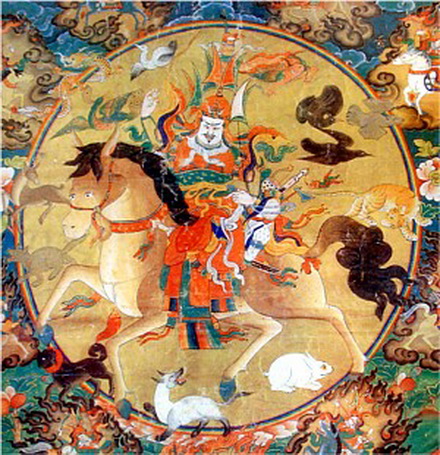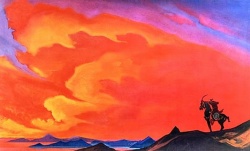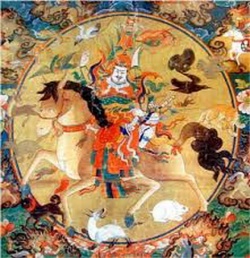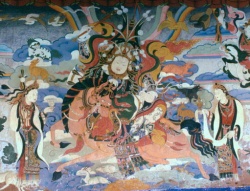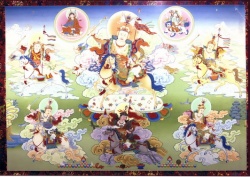Difference between revisions of "Gesar"
| Line 1: | Line 1: | ||
[[Image:Gesar.jpg|frame|Gesar of Ling]] | [[Image:Gesar.jpg|frame|Gesar of Ling]] | ||
| + | |||
| + | |||
| + | |||
| + | |||
| + | |||
| + | |||
| + | |||
'''[[Gesar of Ling]]''' (Tib. {{BigTibetan|[[གླིང་གེ་སར་]]}}, [[Wyl.]] ''[[gling ge sar]]'') — a legendary [[warrior]] [[king]] who is invoked as a [[dharma protectors|protector]] of the teachings. | '''[[Gesar of Ling]]''' (Tib. {{BigTibetan|[[གླིང་གེ་སར་]]}}, [[Wyl.]] ''[[gling ge sar]]'') — a legendary [[warrior]] [[king]] who is invoked as a [[dharma protectors|protector]] of the teachings. | ||
==Commentary== | ==Commentary== | ||
| + | |||
[[Orgyen Tobgyal Rinpoche]] says: | [[Orgyen Tobgyal Rinpoche]] says: | ||
:Some [[people]] think of Ling [[Gesar]] as a famous [[warrior]] [[king]] or general, like [[Wikipedia:Alexander the Great|Alexander the Great]] or the {{Wiki|Chinese}} [[war]] [[gods]]. Others are of the opinion that Ling [[Gesar]] is primarily something like a [[tertön]], an {{Wiki|individual}} blessed by [[Guru Rinpoche]] who [[manifests]] to [[benefit]] [[beings]] through that [[blessing]]. But the real [[nature]] of the [[manifestation]] we know as Ling [[Gesar]] is actually that of [[Guru Rinpoche]] himself appearing in the [[form]] of a ''[[drala]]''. | :Some [[people]] think of Ling [[Gesar]] as a famous [[warrior]] [[king]] or general, like [[Wikipedia:Alexander the Great|Alexander the Great]] or the {{Wiki|Chinese}} [[war]] [[gods]]. Others are of the opinion that Ling [[Gesar]] is primarily something like a [[tertön]], an {{Wiki|individual}} blessed by [[Guru Rinpoche]] who [[manifests]] to [[benefit]] [[beings]] through that [[blessing]]. But the real [[nature]] of the [[manifestation]] we know as Ling [[Gesar]] is actually that of [[Guru Rinpoche]] himself appearing in the [[form]] of a ''[[drala]]''. | ||
| − | [[Namkha Drimé Rinpoche]], who is said to be an [[emanation]] of [[Gesar's]] elder brother, Jatsa Shakar, says that [[Gesar]] is the [[embodiment]] of the [[lords of the three families]], appearing in the [[form]] of a [[drala]]. He is the [[body emanation]] of [[Manjushri]], the [[speech emanation]] of [[Avalokiteshvara]] and the [[mind emanation]] of [[Vajrapani]]. | + | [[Namkha Drimé Rinpoche]], who is said to be an [[emanation]] of [[Gesar's]] elder brother, [[Jatsa]] Shakar, says that [[Gesar]] is the [[embodiment]] of the [[lords of the three families]], appearing in the [[form]] of a [[drala]]. He is the [[body emanation]] of [[Manjushri]], the [[speech emanation]] of [[Avalokiteshvara]] and the [[mind emanation]] of [[Vajrapani]]. |
==Further Reading== | ==Further Reading== | ||
| + | |||
| + | |||
{{Nolinking|*Samuel, Geoffrey. "The Gesar Epic of East Tibet" in Cabezón and Jackson, ''Tibetan Literature: Studies in Genre'', Ithaca: Snow Lion, 1996 | {{Nolinking|*Samuel, Geoffrey. "The Gesar Epic of East Tibet" in Cabezón and Jackson, ''Tibetan Literature: Studies in Genre'', Ithaca: Snow Lion, 1996 | ||
*Stein, R.A. "Introduction to the Ge-sar Epic" in ''Tibet Journal'', Vol. VI, No.1, 1981}} | *Stein, R.A. "Introduction to the Ge-sar Epic" in ''Tibet Journal'', Vol. VI, No.1, 1981}} | ||
| Line 17: | Line 27: | ||
==External Links== | ==External Links== | ||
| + | |||
| + | |||
*[http://www.himalayanart.org/pages/gesar/index.html Outline page for Ling Gesar at Hamalayan Art] | *[http://www.himalayanart.org/pages/gesar/index.html Outline page for Ling Gesar at Hamalayan Art] | ||
*[http://taggiemukpo.org/gesarthanka.html Gesar Wedding Thangka by Gerry Haase] | *[http://taggiemukpo.org/gesarthanka.html Gesar Wedding Thangka by Gerry Haase] | ||
| Line 31: | Line 43: | ||
In all his endeavors, [[Gesar]] is inspired by [[fearless]] [[compassion]]. Unafraid of {{Wiki|chaos}}, he is able to uncover a [[path]] of wakefulness and [[harmony]] even in the most perilous and compromising situations. His unconditional commitment to others gives [[birth]] to the [[confidence]] that always uncovers spontaneous, precise and [[vital]] {{Wiki|expressions}} of [[enlightened mind]]. Thus, he is revered throughout central {{Wiki|Asia}} in [[Buddhist]], [[Shambhala]] and {{Wiki|shamanic}} teachings as the {{Wiki|perfect}} [[warrior]]. | In all his endeavors, [[Gesar]] is inspired by [[fearless]] [[compassion]]. Unafraid of {{Wiki|chaos}}, he is able to uncover a [[path]] of wakefulness and [[harmony]] even in the most perilous and compromising situations. His unconditional commitment to others gives [[birth]] to the [[confidence]] that always uncovers spontaneous, precise and [[vital]] {{Wiki|expressions}} of [[enlightened mind]]. Thus, he is revered throughout central {{Wiki|Asia}} in [[Buddhist]], [[Shambhala]] and {{Wiki|shamanic}} teachings as the {{Wiki|perfect}} [[warrior]]. | ||
| + | |||
===The [[Spirit]] of Renewal=== | ===The [[Spirit]] of Renewal=== | ||
| + | |||
[[Gesar's]] [[character]] in all his journeys is somewhat unique in {{Wiki|Asian}} {{Wiki|folklore}}. He is, even before his [[birth]], an [[enlightened being]]. However he is also a classic {{Wiki|epic}} [[hero]], prey to a range of flaws. Unlike the [[Buddha]] who, having once [[realized]] [[enlightenment]], was invulnerable to [[worldly]] sorrows and blandishments, [[Gesar]] is repeatedly caught in nets of outer and inner conflict. He repeatedly engages his torment a and {{Wiki|confusion}} in order to uncover the freedom of fundamental wakefulness. | [[Gesar's]] [[character]] in all his journeys is somewhat unique in {{Wiki|Asian}} {{Wiki|folklore}}. He is, even before his [[birth]], an [[enlightened being]]. However he is also a classic {{Wiki|epic}} [[hero]], prey to a range of flaws. Unlike the [[Buddha]] who, having once [[realized]] [[enlightenment]], was invulnerable to [[worldly]] sorrows and blandishments, [[Gesar]] is repeatedly caught in nets of outer and inner conflict. He repeatedly engages his torment a and {{Wiki|confusion}} in order to uncover the freedom of fundamental wakefulness. | ||
The deepest impulse in the [[Gesar]] [[tradition]] is the [[constant]] renewal of [[enlightenment]] in the [[world]]. It is this dynamic—the [[constant]] rediscovery of wakefulness and [[compassion]] within the most horrific, grotesque, and frightening situations—that accounts for the [[Gesar]] epic's continued [[vitality]] in its many elaborations. | The deepest impulse in the [[Gesar]] [[tradition]] is the [[constant]] renewal of [[enlightenment]] in the [[world]]. It is this dynamic—the [[constant]] rediscovery of wakefulness and [[compassion]] within the most horrific, grotesque, and frightening situations—that accounts for the [[Gesar]] epic's continued [[vitality]] in its many elaborations. | ||
| + | |||
===A Living [[Tradition]]=== | ===A Living [[Tradition]]=== | ||
| + | |||
One of the world’s most extensive [[bodies]] of {{Wiki|epic}} lore, the [[Gesar]] songs and stories have long focused the {{Wiki|social}} and [[spiritual]] [[aspirations]] of [[Eastern Tibet]], {{Wiki|Western}} [[China]], [[Mongolia]], {{Wiki|Buriatya}}, and the [[Wikipedia:Kalmyk people|Kalmyk]] {{Wiki|Republic}}. This {{Wiki|epic}} [[tradition]] is still alive, in a wide variety of [[forms]], today. | One of the world’s most extensive [[bodies]] of {{Wiki|epic}} lore, the [[Gesar]] songs and stories have long focused the {{Wiki|social}} and [[spiritual]] [[aspirations]] of [[Eastern Tibet]], {{Wiki|Western}} [[China]], [[Mongolia]], {{Wiki|Buriatya}}, and the [[Wikipedia:Kalmyk people|Kalmyk]] {{Wiki|Republic}}. This {{Wiki|epic}} [[tradition]] is still alive, in a wide variety of [[forms]], today. | ||
| Line 47: | Line 63: | ||
The [[Gesar]] {{Wiki|epic}} is unlike the {{Wiki|Mahabharata}}, which [[exists]] in one definitive written [[form]], or the {{Wiki|Ramayana}} which [[exists]] in two. Throughout [[India]] and {{Wiki|Southeast Asia}}, the many theatrical and [[spiritual]] variations of these two great [[Indian]] {{Wiki|epics}} assume the stability of the [[root texts]]. By contrast, there is no “definitive” [[Gesar]] {{Wiki|epic}}, which is constantly evolving, as are its modes of presentation (with some songs and performances containing only selected episodes). In this [[sense]], it is very much a living, improvisatory [[tradition]]. Because its message continues to inspire [[people]] in many cultures to find [[courage]] and {{Wiki|hope}} in the {{Wiki|hardships}} they encounter daily, new renditions of the [[Gesar]] {{Wiki|epic}} have often arisen in times of special uncertainty and [[danger]]. | The [[Gesar]] {{Wiki|epic}} is unlike the {{Wiki|Mahabharata}}, which [[exists]] in one definitive written [[form]], or the {{Wiki|Ramayana}} which [[exists]] in two. Throughout [[India]] and {{Wiki|Southeast Asia}}, the many theatrical and [[spiritual]] variations of these two great [[Indian]] {{Wiki|epics}} assume the stability of the [[root texts]]. By contrast, there is no “definitive” [[Gesar]] {{Wiki|epic}}, which is constantly evolving, as are its modes of presentation (with some songs and performances containing only selected episodes). In this [[sense]], it is very much a living, improvisatory [[tradition]]. Because its message continues to inspire [[people]] in many cultures to find [[courage]] and {{Wiki|hope}} in the {{Wiki|hardships}} they encounter daily, new renditions of the [[Gesar]] {{Wiki|epic}} have often arisen in times of special uncertainty and [[danger]]. | ||
| + | |||
===The [[Heart]] of the Story=== | ===The [[Heart]] of the Story=== | ||
| + | |||
The [[Gesar]] Epic has a core repertoire of episodes. These include [[Gesar's]] [[celestial]] origin and miraculous [[birth]], his childhood and accession to the [[throne]], his four great campaigns against the {{Wiki|demonic}} [[lords]] of the four [[directions]], and his departure from this [[earth]]. Other episodes tell of his battles in foreign lands, undertaken to procure various [[spiritual]] and material riches for the [[people]] of Ling. (These can be found in Rolf Stein’s work, [[Wikipedia:Alexandra David-Néel|Alexandra David Neel’s]] Superhuman [[Life]] of [[Gesar of Ling]], Douglas Penick’s [[Warrior]] Song of [[King Gesar]], and the late Robin Kornman’s forthcoming translation, among others.) | The [[Gesar]] Epic has a core repertoire of episodes. These include [[Gesar's]] [[celestial]] origin and miraculous [[birth]], his childhood and accession to the [[throne]], his four great campaigns against the {{Wiki|demonic}} [[lords]] of the four [[directions]], and his departure from this [[earth]]. Other episodes tell of his battles in foreign lands, undertaken to procure various [[spiritual]] and material riches for the [[people]] of Ling. (These can be found in Rolf Stein’s work, [[Wikipedia:Alexandra David-Néel|Alexandra David Neel’s]] Superhuman [[Life]] of [[Gesar of Ling]], Douglas Penick’s [[Warrior]] Song of [[King Gesar]], and the late Robin Kornman’s forthcoming translation, among others.) | ||
| Line 54: | Line 72: | ||
The episode recounted in this [[book]] is also part of the [[traditional]] [[canon]], but less well known and it tells of [[Gesar’s]] journey to rescue his mother from [[hell]]. To do so, [[Gesar]], after encountering the great [[protectors]] [[Vajrasadhu]] and [[Vetali]], enters the {{Wiki|kingdom}} of [[Yama]], [[Lord of Death]] (part 1) he then travels through the [[six realms]] of [[existence]] and the interim states or [[bardos]] (part2). And afterwards, he visits the [[Kingdom of Shambhala]], where he meets four great [[warrior]] rulers who frame this journey in a [[worldly]] societal context (part 3). Finally, (in part 4), [[King Gesar]] makes his last return to Ling. | The episode recounted in this [[book]] is also part of the [[traditional]] [[canon]], but less well known and it tells of [[Gesar’s]] journey to rescue his mother from [[hell]]. To do so, [[Gesar]], after encountering the great [[protectors]] [[Vajrasadhu]] and [[Vetali]], enters the {{Wiki|kingdom}} of [[Yama]], [[Lord of Death]] (part 1) he then travels through the [[six realms]] of [[existence]] and the interim states or [[bardos]] (part2). And afterwards, he visits the [[Kingdom of Shambhala]], where he meets four great [[warrior]] rulers who frame this journey in a [[worldly]] societal context (part 3). Finally, (in part 4), [[King Gesar]] makes his last return to Ling. | ||
| − | This episode is in some ways the {{Wiki|epitome}} of all [[Gesar’s]] other endeavors. Here he [[experiences]] each of the [[six realms]] of being: [[hell]], the [[realm of hungry ghosts]], [[animals]], [[humans]], [[jealous]] [[gods]], and [[gods]]. These [[realms]] are [[traditional]] in [[Tibetan]], [[Indian]] and other central {{Wiki|Asian}} {{Wiki|cosmologies}}, but even as they may be considered ‘real’ places, they also represent the kinds of [[worlds]] that evolve from our own [[states of mind]]. Thus, when our [[anger]] becomes completely solid, our [[world]] becomes an all-encompassing source of [[pain]]; when our [[craving]] becomes {{Wiki|incessant}}, we inhabit a [[world]] of utter deprivation; willful [[ignorance]] makes a [[world]] of [[endless]] apprehension; [[clinging]] to stability accentuates a [[world]] of [[constant]] change; [[envy]] produces a [[world]] where what is most [[desired]] is in the possession of others; and the [[hallucinations]] of self-absorption flourish in complete [[indifference]]. From this point of [[view]], we may find that all these [[realms]] not just resonate but even [[exist]] in our [[human world]]. | + | This episode is in some ways the {{Wiki|epitome}} of all [[Gesar’s]] other endeavors. Here he [[experiences]] each of the [[six realms]] of being: [[hell]], the [[realm of hungry ghosts]], [[animals]], [[humans]], [[jealous]] [[gods]], and [[gods]]. These [[realms]] are [[traditional]] in [[Tibetan]], [[Indian]] and other central {{Wiki|Asian}} {{Wiki|cosmologies}}, but even as they may be considered ‘real’ places, they also represent the kinds of [[worlds]] that evolve from our [[own]] [[states of mind]]. Thus, when our [[anger]] becomes completely solid, our [[world]] becomes an all-encompassing source of [[pain]]; when our [[craving]] becomes {{Wiki|incessant}}, we inhabit a [[world]] of utter deprivation; willful [[ignorance]] makes a [[world]] of [[endless]] apprehension; [[clinging]] to stability accentuates a [[world]] of [[constant]] change; [[envy]] produces a [[world]] where what is most [[desired]] is in the possession of others; and the [[hallucinations]] of [[self-absorption]] flourish in complete [[indifference]]. From this point of [[view]], we may find that all these [[realms]] not just resonate but even [[exist]] in our [[human world]]. |
At the same [[time]], the actual [[experiences]] of [[anger]], [[craving]], ignoring and so forth are all intensely, even unsparingly alive. We try to harness them to our {{Wiki|narrative}} of a solid [[self]] who achieves goals in a solid [[world]]. But, [[letting go]] of such reference points, the very [[energy]] of the [[passions]] becomes a [[path]] of [[enlightenment]]. [[Passions]] [[awaken]] us to what is real in the [[world]], in ourselves, in [[life]], in dying. Thus, [[Gesar’s]] [[experience]] of each [[realm]] leads him to realize the immediate [[enlightenment]] there. | At the same [[time]], the actual [[experiences]] of [[anger]], [[craving]], ignoring and so forth are all intensely, even unsparingly alive. We try to harness them to our {{Wiki|narrative}} of a solid [[self]] who achieves goals in a solid [[world]]. But, [[letting go]] of such reference points, the very [[energy]] of the [[passions]] becomes a [[path]] of [[enlightenment]]. [[Passions]] [[awaken]] us to what is real in the [[world]], in ourselves, in [[life]], in dying. Thus, [[Gesar’s]] [[experience]] of each [[realm]] leads him to realize the immediate [[enlightenment]] there. | ||
| − | Although in this rendition, the [[six realms]] and the [[Buddhas]] within them are represented [[traditionally]], this story [[lives]] beyond its original {{Wiki|cultural}} framework. The inner [[truth]] of [[Gesar’s]] journey is not ultimately confined to any specific [[imagery]]. The {{Wiki|demonic}} figures are {{Wiki|expressions}} of our own inner terrors; the [[Buddhas]] (literally: ‘[[awakened ones]]’) refer to the intrinsic clarity and vividness of our own [[minds]]. Beyond any specific {{Wiki|cultural}} or [[spiritual]] [[tradition]], [[Gesar]] continues to provoke and inspire because we continually [[sense]] that there is an intensity, a [[truthfulness]] beyond our own limitations, and we continue to dare to seek it, even beyond the limits of [[life]] and [[death]]. | + | Although in this rendition, the [[six realms]] and the [[Buddhas]] within them are represented [[traditionally]], this story [[lives]] beyond its original {{Wiki|cultural}} framework. The inner [[truth]] of [[Gesar’s]] journey is not ultimately confined to any specific [[imagery]]. The {{Wiki|demonic}} figures are {{Wiki|expressions}} of our [[own]] inner terrors; the [[Buddhas]] (literally: ‘[[awakened ones]]’) refer to the intrinsic clarity and vividness of our [[own]] [[minds]]. Beyond any specific {{Wiki|cultural}} or [[spiritual]] [[tradition]], [[Gesar]] continues to provoke and inspire because we continually [[sense]] that there is an intensity, a [[truthfulness]] beyond our [[own]] limitations, and we continue to dare to seek it, even beyond the limits of [[life]] and [[death]]. |
| − | The preceding has relied on oral teahings by the [[Vidyadhara]], the [[Venerable]] [[Chogyam Trungpa]], [[Rinpoche]], [[His Holiness]] [[Orgyen Kusum Lingpa]], the [[Venerable]] [[Tulku Thondup]], the [[Venerable]] [[Chagdud Tulku Rinpoche]], the [[Venerable]] Yangthang [[Tulku]], and the [[Venerable]] [[Namkhai]] Drimed [[Rinpoche]]. I am also deeply indebted to Ives Waldo, the late Robin Kornman, Blake Thomson, and the works of R.A. Stein, Alexandra David Neel, Ida Zeitlin, and Geoffrey Samuels. | + | The preceding has relied on oral teahings by the [[Vidyadhara]], the [[Venerable]] [[Chogyam Trungpa]], [[Rinpoche]], [[His Holiness]] [[Orgyen Kusum Lingpa]], the [[Venerable]] [[Tulku Thondup]], the [[Venerable]] [[Chagdud Tulku Rinpoche]], the [[Venerable]] Yangthang [[Tulku]], and the [[Venerable]] [[Namkhai]] Drimed [[Rinpoche]]. I am also deeply indebted to Ives Waldo, the late [[Robin Kornman]], Blake Thomson, and the works of R.A. Stein, Alexandra David Neel, Ida Zeitlin, and Geoffrey Samuels. |
{{R}} | {{R}} | ||
| + | [[Category:Buddhist Terms]] | ||
[[Category:Gesar Ling]] | [[Category:Gesar Ling]] | ||
[[Category:Historical Figures]] | [[Category:Historical Figures]] | ||
[[Category:Tibetan Buddhism]] | [[Category:Tibetan Buddhism]] | ||
Latest revision as of 16:17, 30 March 2023
Gesar of Ling (Tib. གླིང་གེ་སར་, Wyl. gling ge sar) — a legendary warrior king who is invoked as a protector of the teachings.
Commentary
Orgyen Tobgyal Rinpoche says:
- Some people think of Ling Gesar as a famous warrior king or general, like Alexander the Great or the Chinese war gods. Others are of the opinion that Ling Gesar is primarily something like a tertön, an individual blessed by Guru Rinpoche who manifests to benefit beings through that blessing. But the real nature of the manifestation we know as Ling Gesar is actually that of Guru Rinpoche himself appearing in the form of a drala.
Namkha Drimé Rinpoche, who is said to be an emanation of Gesar's elder brother, Jatsa Shakar, says that Gesar is the embodiment of the lords of the three families, appearing in the form of a drala. He is the body emanation of Manjushri, the speech emanation of Avalokiteshvara and the mind emanation of Vajrapani.
Further Reading
- Samuel, Geoffrey. "The Gesar Epic of East Tibet" in Cabezón and Jackson, Tibetan Literature: Studies in Genre, Ithaca: Snow Lion, 1996
- Stein, R.A. "Introduction to the Ge-sar Epic" in Tibet Journal, Vol. VI, No.1, 1981
See Also
External Links
- Outline page for Ling Gesar at Hamalayan Art
- Gesar Wedding Thangka by Gerry Haase
- Gesar Series on Lotsawa House
Source
Perhaps this will help. It's an introduction to my CROSSINGS ON A BRIDGE OF LIGHT. I hope it's of use.
Many thanks,
Douglas Penick
The Gesar epic is a vast assemblage of literature that recounts the struggles of Gesar Norbu Dradul, the legendary 12th century King of Ling in Eastern Tibet. Gesar was renowned for the many battles and quests he undertook to secure the wellbeing, prosperity and peace of his embattled kingdom, and he came to be regarded as the embodiment of continuous cultural and spiritual renewal.
In all his endeavors, Gesar is inspired by fearless compassion. Unafraid of chaos, he is able to uncover a path of wakefulness and harmony even in the most perilous and compromising situations. His unconditional commitment to others gives birth to the confidence that always uncovers spontaneous, precise and vital expressions of enlightened mind. Thus, he is revered throughout central Asia in Buddhist, Shambhala and shamanic teachings as the perfect warrior.
The Spirit of Renewal
Gesar's character in all his journeys is somewhat unique in Asian folklore. He is, even before his birth, an enlightened being. However he is also a classic epic hero, prey to a range of flaws. Unlike the Buddha who, having once realized enlightenment, was invulnerable to worldly sorrows and blandishments, Gesar is repeatedly caught in nets of outer and inner conflict. He repeatedly engages his torment a and confusion in order to uncover the freedom of fundamental wakefulness.
The deepest impulse in the Gesar tradition is the constant renewal of enlightenment in the world. It is this dynamic—the constant rediscovery of wakefulness and compassion within the most horrific, grotesque, and frightening situations—that accounts for the Gesar epic's continued vitality in its many elaborations.
A Living Tradition
One of the world’s most extensive bodies of epic lore, the Gesar songs and stories have long focused the social and spiritual aspirations of Eastern Tibet, Western China, Mongolia, Buriatya, and the Kalmyk Republic. This epic tradition is still alive, in a wide variety of forms, today.
Itinerant Gesar singers perpetuate the saga’s basic episodes and characters in improvised songs and chants, with some illiterate singers pretending to recite from written texts, and others unfurling scrolls that depict the tales of their songs. In eastern Tibet and elsewhere, an elaborate theatrical tradition boasts distinctive dances, costumes, and backdrops.
The epic has also been composed in written form, most famously in the early 20th century at the behest of Ju Mipham Rinpoche, the great Nyingma lama and scholar. This written tradition includes many liturgies invoking Gesar as a deity, protector, and spiritual guide. Of the written versions now available to us from Tibet, Mongolia, and Ladakh, many were adapted in whole or in part from the songs and performances of one or more singers. Meanwhile new episodes have continued to appear in response to the inspiration and needs of the time. One lama, for example, hearing of the horrors of World War Two, composed an episode in which Gesar went to Germany to conquer Hitler.
The Gesar epic is unlike the Mahabharata, which exists in one definitive written form, or the Ramayana which exists in two. Throughout India and Southeast Asia, the many theatrical and spiritual variations of these two great Indian epics assume the stability of the root texts. By contrast, there is no “definitive” Gesar epic, which is constantly evolving, as are its modes of presentation (with some songs and performances containing only selected episodes). In this sense, it is very much a living, improvisatory tradition. Because its message continues to inspire people in many cultures to find courage and hope in the hardships they encounter daily, new renditions of the Gesar epic have often arisen in times of special uncertainty and danger.
The Heart of the Story
The Gesar Epic has a core repertoire of episodes. These include Gesar's celestial origin and miraculous birth, his childhood and accession to the throne, his four great campaigns against the demonic lords of the four directions, and his departure from this earth. Other episodes tell of his battles in foreign lands, undertaken to procure various spiritual and material riches for the people of Ling. (These can be found in Rolf Stein’s work, Alexandra David Neel’s Superhuman Life of Gesar of Ling, Douglas Penick’s Warrior Song of King Gesar, and the late Robin Kornman’s forthcoming translation, among others.)
The episode recounted in this book is also part of the traditional canon, but less well known and it tells of Gesar’s journey to rescue his mother from hell. To do so, Gesar, after encountering the great protectors Vajrasadhu and Vetali, enters the kingdom of Yama, Lord of Death (part 1) he then travels through the six realms of existence and the interim states or bardos (part2). And afterwards, he visits the Kingdom of Shambhala, where he meets four great warrior rulers who frame this journey in a worldly societal context (part 3). Finally, (in part 4), King Gesar makes his last return to Ling.
This episode is in some ways the epitome of all Gesar’s other endeavors. Here he experiences each of the six realms of being: hell, the realm of hungry ghosts, animals, humans, jealous gods, and gods. These realms are traditional in Tibetan, Indian and other central Asian cosmologies, but even as they may be considered ‘real’ places, they also represent the kinds of worlds that evolve from our own states of mind. Thus, when our anger becomes completely solid, our world becomes an all-encompassing source of pain; when our craving becomes incessant, we inhabit a world of utter deprivation; willful ignorance makes a world of endless apprehension; clinging to stability accentuates a world of constant change; envy produces a world where what is most desired is in the possession of others; and the hallucinations of self-absorption flourish in complete indifference. From this point of view, we may find that all these realms not just resonate but even exist in our human world.
At the same time, the actual experiences of anger, craving, ignoring and so forth are all intensely, even unsparingly alive. We try to harness them to our narrative of a solid self who achieves goals in a solid world. But, letting go of such reference points, the very energy of the passions becomes a path of enlightenment. Passions awaken us to what is real in the world, in ourselves, in life, in dying. Thus, Gesar’s experience of each realm leads him to realize the immediate enlightenment there.
Although in this rendition, the six realms and the Buddhas within them are represented traditionally, this story lives beyond its original cultural framework. The inner truth of Gesar’s journey is not ultimately confined to any specific imagery. The demonic figures are expressions of our own inner terrors; the Buddhas (literally: ‘awakened ones’) refer to the intrinsic clarity and vividness of our own minds. Beyond any specific cultural or spiritual tradition, Gesar continues to provoke and inspire because we continually sense that there is an intensity, a truthfulness beyond our own limitations, and we continue to dare to seek it, even beyond the limits of life and death.
The preceding has relied on oral teahings by the Vidyadhara, the Venerable Chogyam Trungpa, Rinpoche, His Holiness Orgyen Kusum Lingpa, the Venerable Tulku Thondup, the Venerable Chagdud Tulku Rinpoche, the Venerable Yangthang Tulku, and the Venerable Namkhai Drimed Rinpoche. I am also deeply indebted to Ives Waldo, the late Robin Kornman, Blake Thomson, and the works of R.A. Stein, Alexandra David Neel, Ida Zeitlin, and Geoffrey Samuels.
